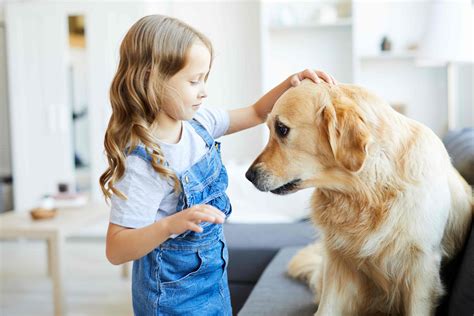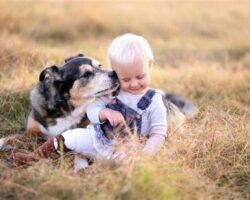Are you a parent considering getting a dog for your family? Or perhaps you already have both children and a furry friend at home? Either way, it’s essential to ensure that your children know how to interact safely with pets. In this blog post, we will discuss the important steps and guidelines for teaching kids to interact with dogs in a secure, respectful manner. From introducing dogs to children and understanding canine body language to setting boundaries and using positive reinforcement, we will cover everything you need to know to create a harmonious and safe environment for both your children and your beloved pets. Whether you’re a dog owner or simply want to educate your children about pet interaction, this blog post will provide valuable insights and practical tips for fostering a healthy and happy relationship between dogs and children.
Introducing Dogs to Children: A Step-by-Step Guide
Introducing a dog to children can be a wonderful and rewarding experience, but it’s important to take things slowly and carefully to ensure that both the dog and the children are comfortable and safe. First and foremost, it’s crucial to teach children basic dog etiquette and rules for interacting with their new furry friend. This includes things like not pulling on the dog’s tail or ears, not bothering the dog while it’s eating or sleeping, and always asking an adult for permission before approaching the dog. By setting these boundaries early on, you can help to prevent any potential conflicts or misunderstandings between the dog and the children.
Understanding canine body language is also essential when introducing a dog to children. It’s important for kids to be able to recognize when a dog is feeling anxious, scared, or stressed, so they know when to give the dog some space. Teaching children to respect a dog’s personal space and boundaries is crucial for creating a safe and positive interaction between the dog and the kids. By giving the dog the space it needs and allowing it to approach the children on its own terms, you can help to build trust and confidence in both the dog and the kids.
Positive reinforcement is key when it comes to encouraging gentle interactions between dogs and children. Teaching kids to use gentle touches, soft voices, and positive reinforcement when interacting with the dog will help to create a positive and trusting relationship between the two. It’s important to always supervise interactions between dogs and children, especially in the beginning, to ensure that playtime is safe and enjoyable for everyone. Teaching children how to approach and greet dogs safely is also crucial for preventing any accidents or misunderstandings.
Finally, teaching children how to respond to aggression or fear in dogs is an important part of introducing dogs to children. Kids should know how to react if a dog growls, barks, or shows signs of fear or aggression. Teaching children to stay calm, stand still, and avoid making sudden movements can help to defuse a potentially tense situation and prevent any conflicts or injuries. By following these step-by-step guidelines and teaching children the basics of dog etiquette, canine body language, and positive reinforcement, you can help to create a safe, positive, and rewarding relationship between dogs and children.
Teaching Children Basic Dog Etiquette
Teaching children basic dog etiquette is crucial for ensuring the safety and well-being of both the child and the dog. It is important to instill in children from a young age the importance of respecting and understanding the needs of their furry friends.
One of the first things to teach children is to ask for permission before approaching a dog. Whether it is their own pet or a stranger’s, children should understand that not all dogs are friendly and may not want to be petted.
Additionally, children should be taught to approach dogs calmly and give them space. Sudden movements or loud noises can startle a dog and lead to a negative reaction. By teaching children to approach dogs slowly and gently, they are more likely to have positive interactions.
It is also important to teach children to recognize signs of stress or discomfort in dogs. This includes understanding body language such as growling, baring teeth, or a stiff posture. By teaching children to recognize these signs, they can learn when to back off and give the dog space.
Understanding Canine Body Language: Essential for Kids
Understanding canine body language is crucial for children to ensure safe interactions with dogs. Dogs communicate through their body language, and it is essential for kids to be able to recognize the signs to prevent potential accidents or misunderstandings.
Teaching children about canine body language can help them understand when a dog is feeling scared, threatened, or playful. This knowledge will enable children to respond appropriately and avoid putting themselves or the dog in a dangerous situation.
Common signs of distress in dogs, such as bared teeth, growling, or a cowering posture, can indicate that the dog is feeling uncomfortable or stressed. By teaching kids to recognize these signals, they can learn to give the dog space and respect their boundaries.
By understanding canine body language, kids can also learn to approach and greet dogs safely, knowing when a dog is open to interaction and when to give them their space. This knowledge is essential for fostering positive and harmonious relationships between children and dogs.
Setting Boundaries: Teaching Children to Respect Dogs’ Space
Teaching children to respect dogs’ space is crucial for ensuring the safety and well-being of both the child and the dog. Dogs, like people, need their own personal space and boundaries. It is important for children to understand and respect this in order to prevent any potential conflicts or accidents.
One of the first steps in teaching children to respect dogs’ space is to establish clear boundaries. This means setting rules for where the dog’s bed or crate is located, where the dog is allowed to eat, and where the dog is allowed to go to relax. By consistently enforcing these boundaries, children can learn to understand and respect the dog’s need for personal space.
It’s also important to teach children to recognize signs of stress or discomfort in dogs. This includes understanding canine body language such as a dog licking its lips, yawning, or showing the whites of its eyes. By teaching children to identify these signs, they can learn when a dog needs space and when it’s best to leave the dog alone.
Lastly, positive reinforcement is key in teaching children to respect dogs’ space. When a child follows the rules and shows respect for the dog’s boundaries, it’s important to praise and reward them. This positive reinforcement will help them understand the importance of respecting the dog’s space and will encourage them to continue doing so in the future.
Positive Reinforcement: Encouraging Gentle Interactions
Positive reinforcement is an essential tool when it comes to teaching children how to interact with dogs in a gentle and respectful manner. By using positive reinforcement, we can encourage children to develop a positive association with dogs, and to understand the importance of gentle interactions.
Positive reinforcement involves rewarding desired behaviors, such as gentle petting or calm body language, with praise, treats, or other positive reinforcement. This can help children understand that gentle interactions with dogs are not only expected, but also greatly rewarding.
It’s important to consistently reinforce gentle interactions with positive reinforcement, as this can help children develop a lifelong habit of treating dogs with kindness and respect. This can also lead to safer and more enjoyable interactions for both the child and the dog.
By encouraging gentle interactions through positive reinforcement, we can help children build a strong and positive relationship with dogs, and foster a sense of empathy and understanding towards animals.
Supervision is Key: Ensuring Safe Playtime for Dogs and Kids
When it comes to playtime between dogs and kids, supervision is absolutely essential. Dogs, no matter how well-trained or well-behaved, can still act unpredictably, especially around children. It’s important for adults to always be present and attentive during playtime to ensure the safety and well-being of both the dog and the child.
One of the key reasons for the need for supervision is to be able to intervene if necessary. If a child is playing too rough with the dog, or if the dog is showing signs of stress or discomfort, the responsible adult can step in and redirect the interaction. This can prevent any potential accidents or negative experiences for either party.
Additionally, supervision allows adults to teach kids the importance of respecting the dog’s boundaries and signals. By observing the interaction, adults can explain to the child how to interpret the dog’s body language and adjust their behavior accordingly. This not only keeps both the child and the dog safe, but it also helps to foster a positive and respectful relationship between the two.
Ultimately, supervision is key in ensuring that playtime between dogs and kids is a positive and enjoyable experience for everyone involved. By being present and attentive, adults can prevent accidents, teach valuable lessons, and promote a safe and harmonious relationship between the two.
Teaching Children How to Approach and Greet Dogs Safely
Teaching children how to approach and greet dogs safely is crucial for both the child’s safety and the well-being of the dog. Children can often be unpredictable and impulsive, which can lead to dangerous situations when interacting with dogs. It is important to teach children the proper way to approach and greet dogs to prevent any potential accidents.
One of the first things to teach children is to always ask for permission before approaching a dog. Encourage them to approach the dog calmly and slowly, and to always allow the dog to initiate the interaction. It’s important for children to understand that not all dogs are comfortable with being approached, and it’s crucial to respect the dog‘s boundaries.
Teach children to always approach a dog from the side, rather than head-on, as this can be less intimidating for the dog. It’s also essential for them to learn to avoid making direct eye contact with the dog, as this can be seen as a sign of aggression in the dog‘s body language.
Additionally, it’s important for children to understand the appropriate way to greet a dog. Encourage them to gently extend their hand for the dog to sniff, rather than reaching out to pet the dog right away. Teach them to pet the dog gently and to avoid any rough or sudden movements. By teaching children these key principles, they can learn to approach and greet dogs in a safe and respectful manner.
Teaching Children How to Respond to Aggression or Fear in Dogs
When it comes to teaching children how to respond to aggression or fear in dogs, it’s crucial to emphasize the importance of staying calm and not escalating the situation. Children should be taught to never run away from a fearful or aggressive dog, as this can trigger the dog’s prey drive and lead to a chase. Instead, they should be encouraged to stand still, avoid making eye contact, and slowly back away from the dog without turning their back on it.
Another important aspect of teaching children how to respond to aggression or fear in dogs is educating them on the warning signs that a dog may exhibit when feeling threatened or anxious. Children should be familiar with canine body language, such as bared teeth, flattened ears, raised hackles, and growling. By recognizing these signs, they can gauge the dog’s emotional state and know when to give the dog space and avoid potential confrontation.
It’s also essential to instill in children the concept of respecting a dog’s boundaries. They should understand that just like humans, dogs have their own personal space and should not be approached when they are eating, sleeping, or resting. Teaching children to set boundaries and recognize when a dog needs its own space can help prevent situations that may trigger aggression or fear in dogs.
Lastly, positive reinforcement is key in teaching children how to respond to aggression or fear in dogs. Encouraging gentle interactions and rewarding the child for displaying the appropriate behavior around dogs can help create a positive association and build trust between the child and the dog. When children understand how to respect a dog’s boundaries, interpret its body language, and respond appropriately to aggression or fear, they can foster a safer and more harmonious relationship with their furry companions.





